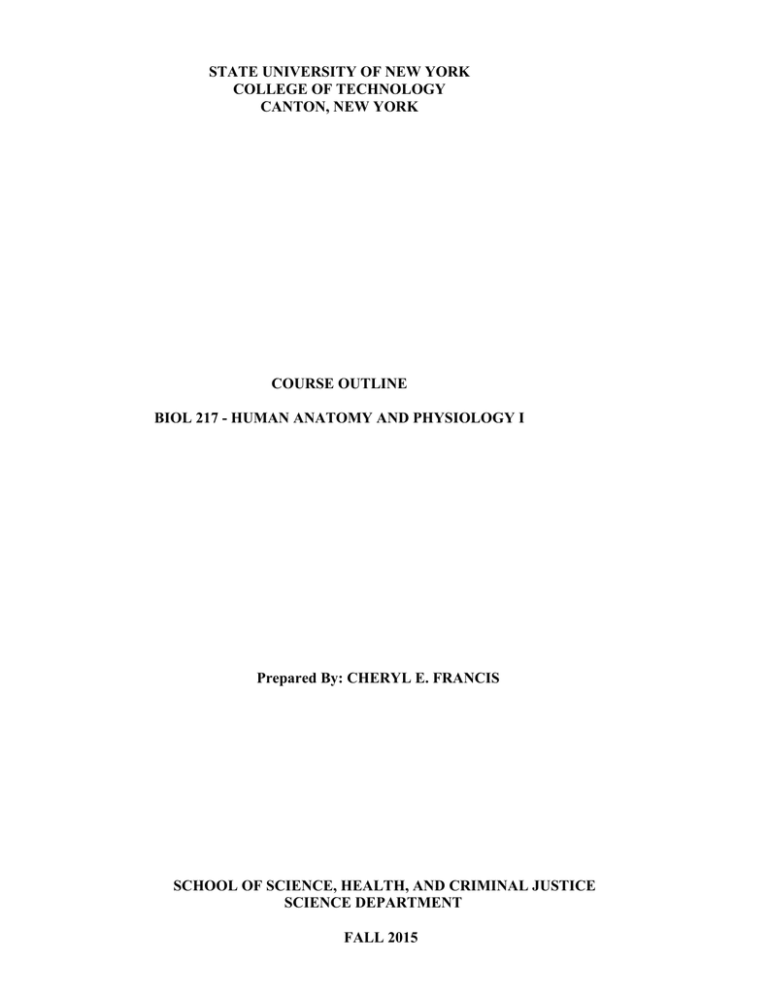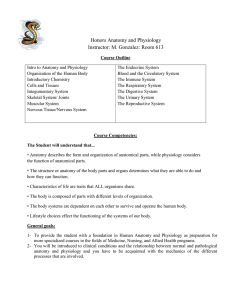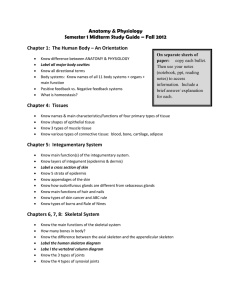STATE UNIVERSITY OF NEW YORK COLLEGE OF TECHNOLOGY CANTON, NEW YORK
advertisement

STATE UNIVERSITY OF NEW YORK COLLEGE OF TECHNOLOGY CANTON, NEW YORK COURSE OUTLINE BIOL 217 - HUMAN ANATOMY AND PHYSIOLOGY I Prepared By: CHERYL E. FRANCIS SCHOOL OF SCIENCE, HEALTH, AND CRIMINAL JUSTICE SCIENCE DEPARTMENT FALL 2015 HUMAN ANATOMY AND PHYSIOLOGY I A. TITLE: Human Anatomy and Physiology I B. COURSE NUMBER: BIOL 217 C. CREDIT HOURS: 4 D. WRITING INTENSIVE COURSE: NA E. COURSE LENGTH: 15 weeks F. SEMESTER OFFERED: Fall/Spring G. HOURS OF LECTURE, LAB: 3 hours lecture and 3 hours lab per week. H. CATALOG DESCRIPTION: This course is the first course in a sequence which studies the anatomy and physiology of the human body in detail. Topics covered in this first semester course include an introduction to the basic plan and organization of the body, basic biochemistry, basic cell structure and cell physiology and the anatomy and physiology of the integumentary, skeletal, muscular and nervous systems. The laboratory sessions will explore detailed anatomy using models and specimens, and experimental physiological concepts. This course is appropriate for students in the nursing, physical therapy assistant, occupational therapy assistant and other health-related fields that require a two-semester Anatomy and Physiology sequence. I. PRE-REQUISITES: High School Regents Biology of 75 or above or BIOL 101 Introduction to Biology or BIOL 102 Introduction to Human Biology, and High School Regents Chemistry of 65 or above or CHEM 101 Introduction to Chemistry. J. STUDENT LEARNING OUTCOMES (SLO): Course Objective 1. Demonstrate competence in prerequisite concept knowledge by identifying and describing basic cellular anatomy and describing basic cellular physiology and basic body chemistry. 2. Describe and explain the importance of the anatomical position and demonstrate the appropriate usage of anatomical terminology. 3. Identify, list, locate and describe the microscopic anatomy of the different tissues and tissue membranes of the body and describe their functions. 4. Identify, list, locate and describe the different structures of the integumentary system and describe their functions. 5. Identify, list, locate and describe the different structures of the skeletal system and articulations and describe their functions. 6. Identify, list, locate and describe the different structures of the muscular system and describe their functions. 7. Identify, list, locate and describe the different structures of the nervous system and describe their functions. K. Institutional SLO 3. Professional competence 3. Professional competence 3. Professional competence 3. Professional competence 3. Professional competence 3. Professional competence 3. Professional competence TEXTS: TEXT: Marieb, Elaine N and Hoehn, Katja., Anatomy and Physiology 5th ed., 2014.Pearson. Another appropriate Human Anatomy and Physiology text could also be used. LABORATORY MANUAL: Internally or externally published lab manual. L. REFERENCES: NA M. FACILITIES/EQUIPMENT: Large lecture hall with computer, LCD projector and document camera and chalk/whiteboard. Laboratory with microscopes, models and computer/monitor technology and space for dissection and storage of specimens. N. GRADING METHOD: A B+ B C+ C D+ D F 90 or above 85-89 80-84 75-79 70-74 65-69 60-64 Below 60 O. MEASUREMENT CRITERIA/METHODS: 65% - In-class quizzes In -class projects/assignments Online quizzes Hourly exams Midterm exam Final exam 35%-Laboratory practicums, assignments P. GENERAL TOPIC OUTLINE: I. Body Plan and Organization II. Homeostasis III. Basic Chemistry of the Body IV. Cell Biology Review V. Histology- Tissues VI. Integumentary System VII. Membranes VIII. Skeletal System IX. Muscular System X. Nervous System XI. Special Senses Q. DETAILED TOPIC OUTLINE: I. Body Plan and Organization A. Anatomical position B. Body planes and sections C. Body cavities and regions D. Directional terms E. Levels of organizational F. Basic terminology II. Homeostasis A. Homeostatic mechanisms B. Control systems C. Negative feedback D. Positive feedback III. Chemistry of the Body A. General Chemistry. B. Biochemistry of organic compounds. C. Structure and function of enzymes. D. Protein synthesis. IV. Cell Biology Review A. Cell structure B. Basic cell physiology C. Membrane structure D. Passive and active transport mechanisms E. Cell division V. Histology-Tissues A. Structure and functions of: 1. Epithelial tissues 2. Connective tissues 3. Muscle tissues 4. Nervous tissues VI. Integumentary System A. Gross and microscopic anatomy B. General functions of the skin C. Structure and function of accessory structures VII. Membranes A. Epithelial membranes- mucous and serous membranes. B. Connective tissue membranes. VIII. Skeletal System A. Histology, growth, development and function of skeletal cartilages. B. General functions of bones and the skeletal system. C. Histology and structure of bones. D. Physiology of bone formation, growth, remodeling and repair. E. Names and markings of bones. F. Organization of the skeleton. G. Classification of joints. H. Structure and function of joints. IX. Muscular System A. General functions of muscle tissue. B. Identification, general location and comparative characteristics of skeletal, smooth and cardiac muscle. C. Detailed gross and microscopic anatomy of skeletal muscles. D. Physiology of skeletal muscle contraction. E. Skeletal muscle metabolism. F. Types of whole muscle contractions. G. Nomenclature of skeletal muscles. H. Location and actions of major skeletal muscles. I. Group mechanics of skeletal muscles. X. Nervous System A. General functions of the nervous system. B. Structural and functional organization of the nervous system. C. Histology of nervous tissue. D. Gross anatomy of the nervous system. E. Neurophysiology: impulse production, propagation and synaptic transmission. F. Neural integration. G. General senses. XI. Special Senses A. Gross and microscopic anatomy, function of the eye. B Gross and microscopic anatomy, function of the ear. C. Gross and microscopic anatomy, function of the olfactory epithelium. D. Gross and microscopic anatomy, function of the taste buds. R. LABORATORY OUTLINE: I. Microscope use; Cellular anatomy and physiology II. Histology - epithelial, connective, muscle and nervous tissues III. Use of anatomical terminology IV. Histology of the integumentary system V. Bones of the vertebral column, thorax VI. Bones of the skull VII. Bones of the appendicular skeleton VIII. Muscles of the skeletal muscular system IX. Nervous system histology; cells of the nervous system X. Structures of the central nervous system XI. Structures of the peripheral nervous system XII. Anatomy and physiology of the general senses XIII. Anatomy and physiology of the special senses; eye and ear, olfactory epithelium and taste buds




